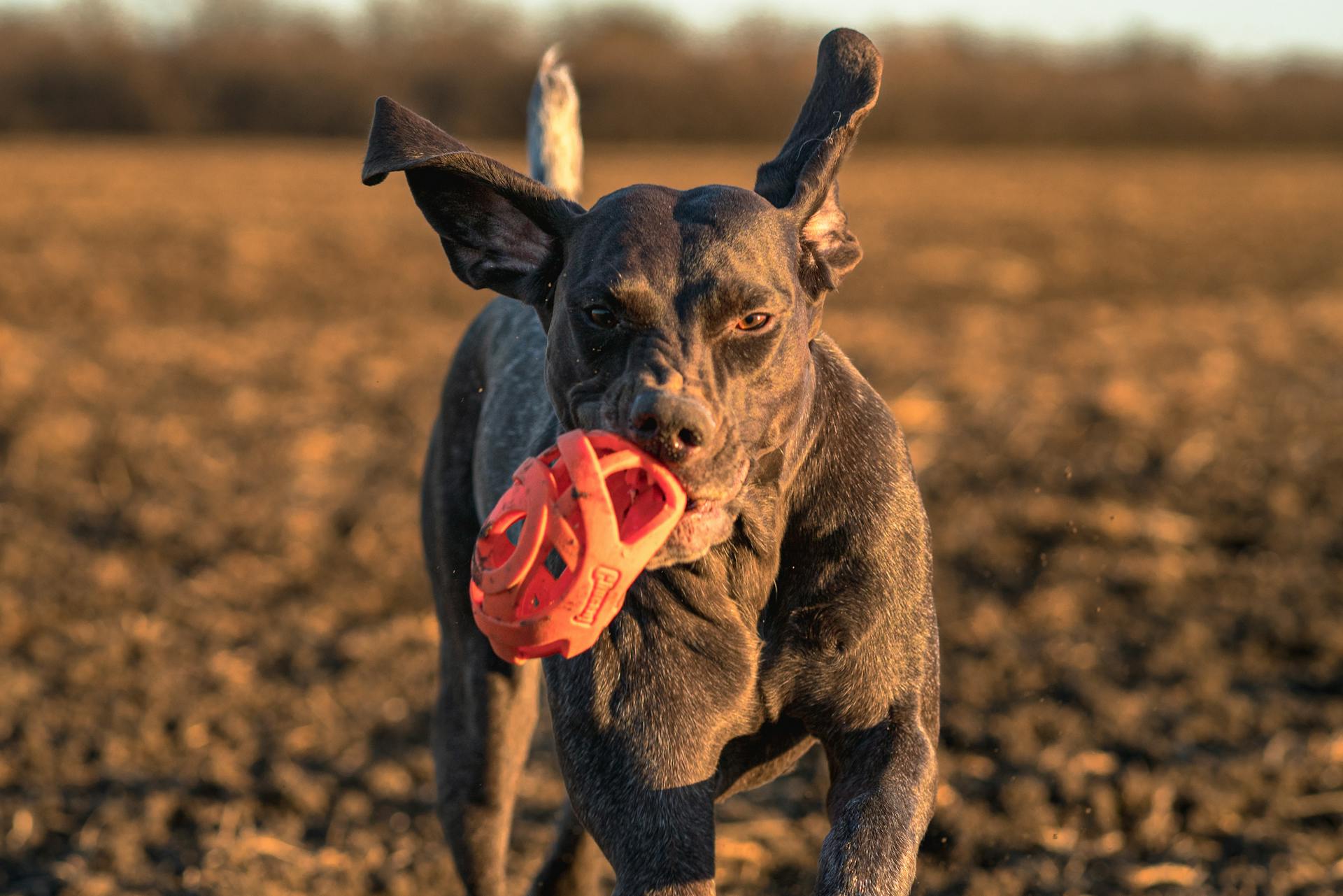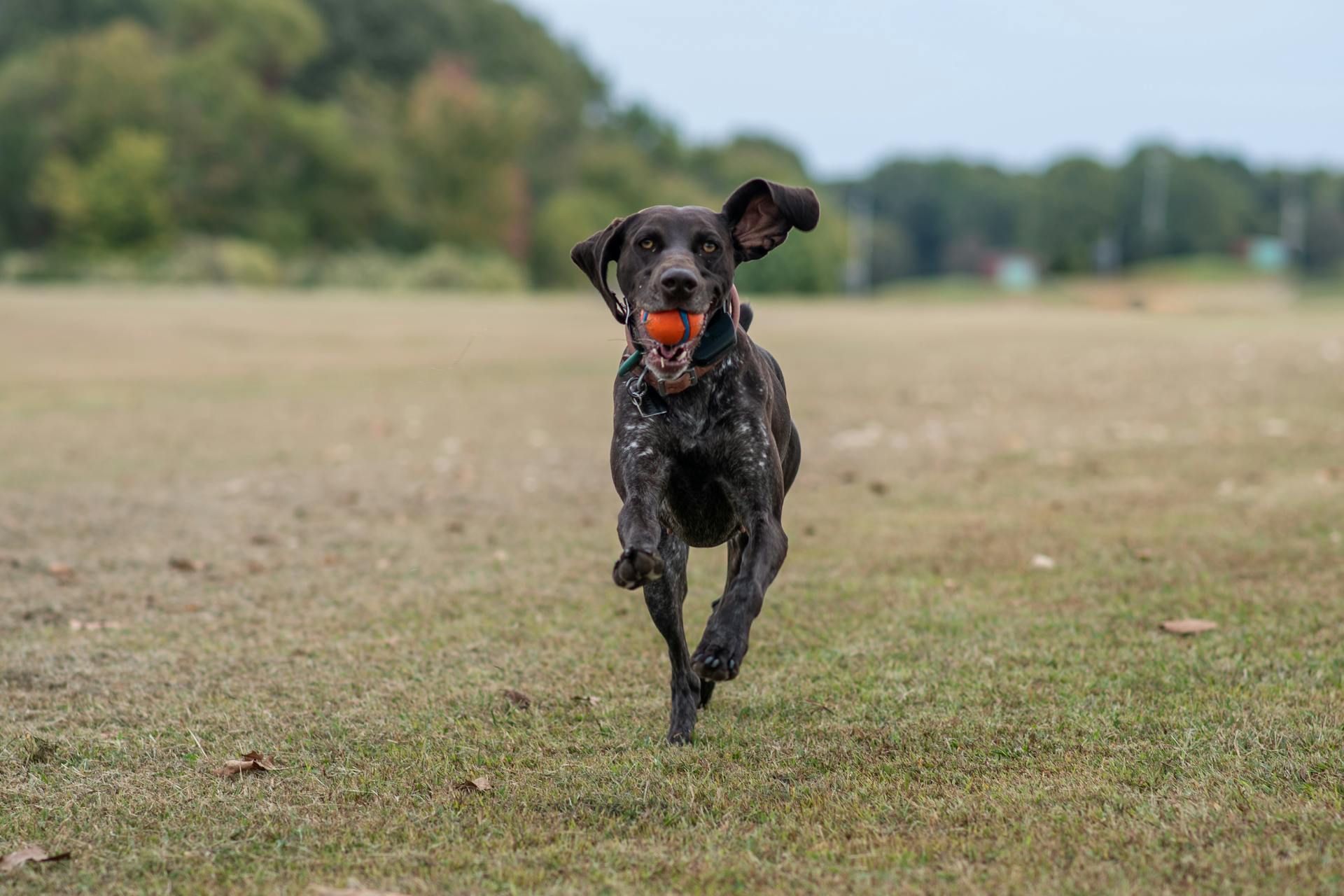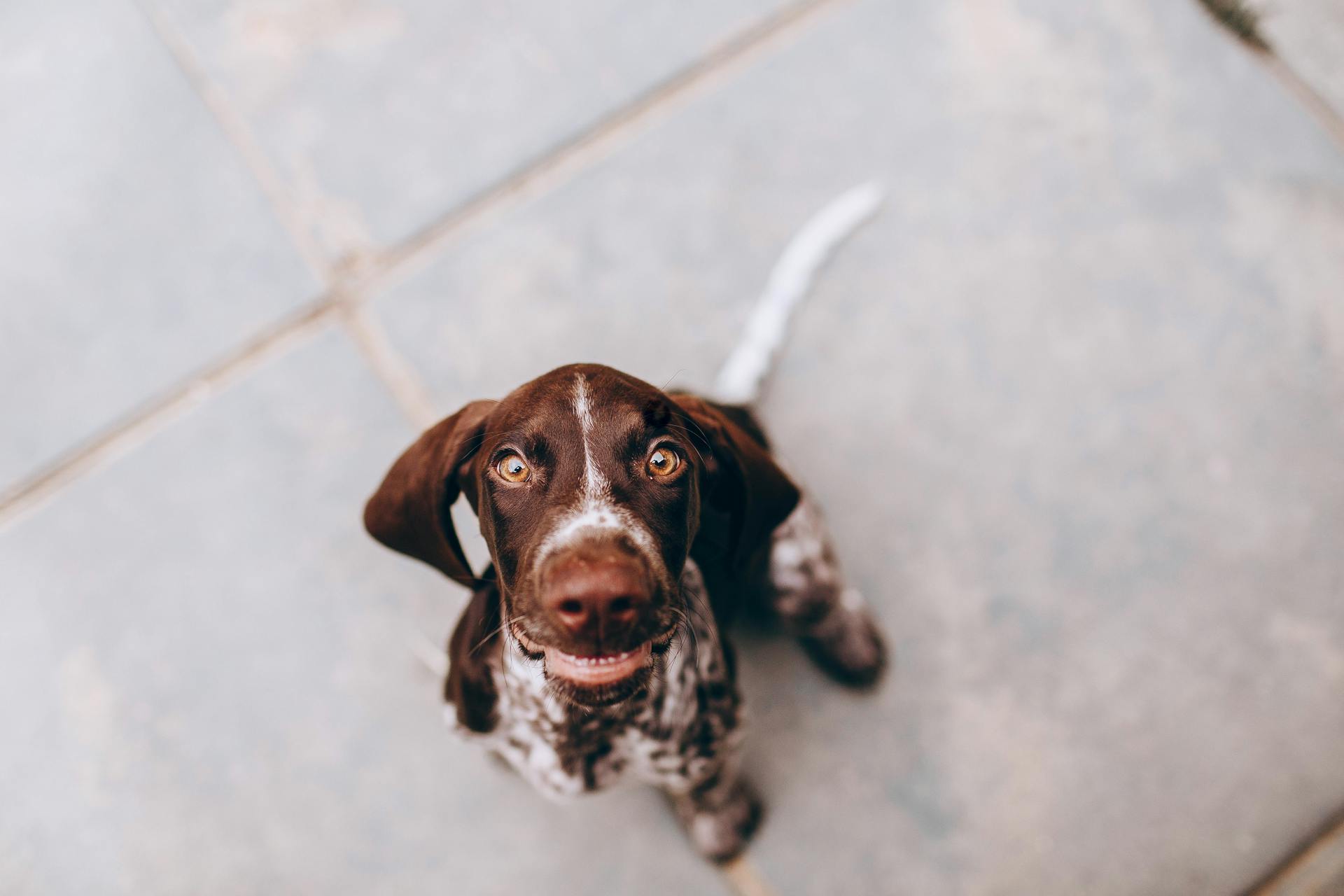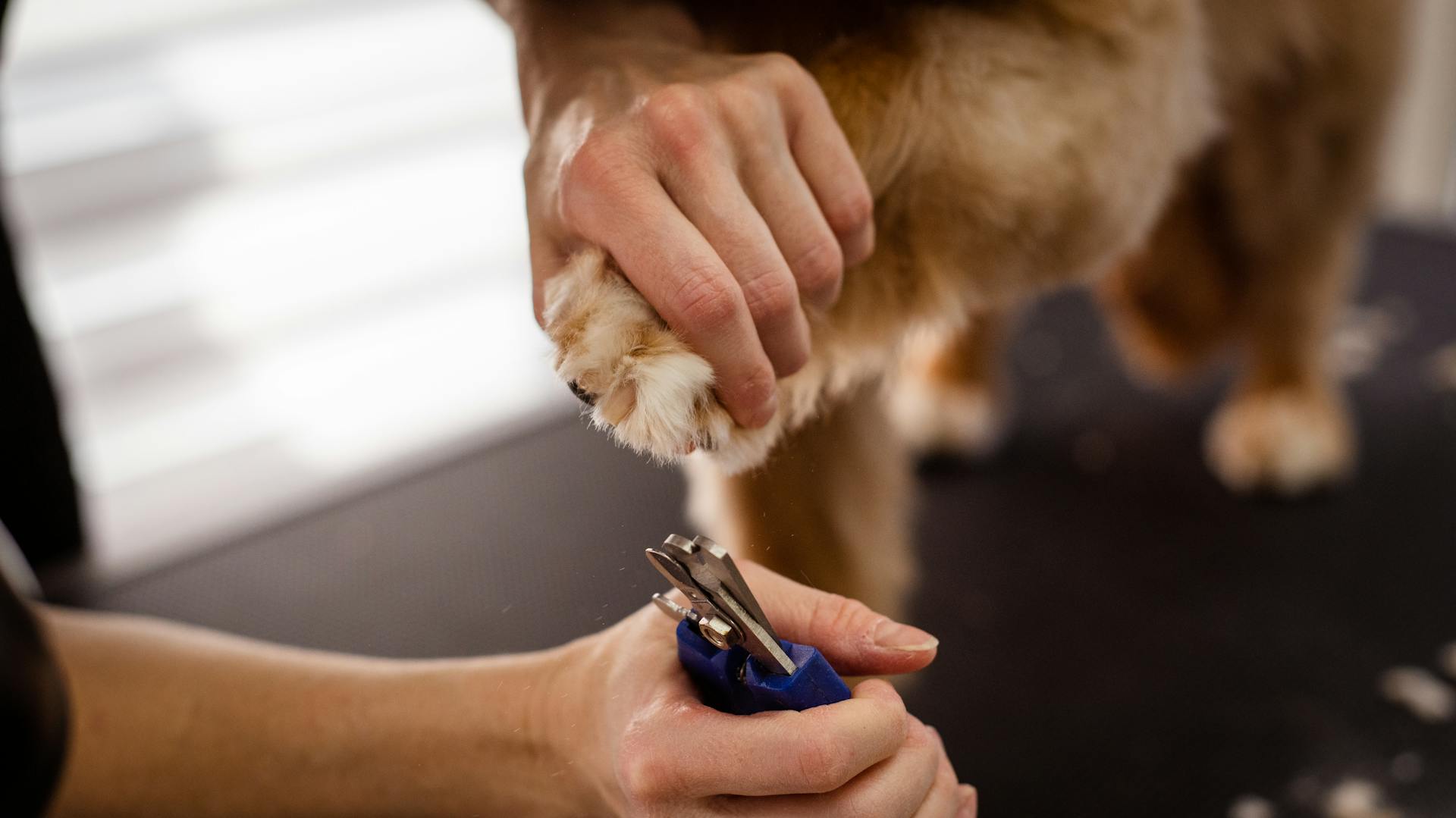
The German Wirehaired Pointer is a versatile hunting dog that's also a loving family pet. They originated in Germany in the late 1800s.
This breed is known for its distinctive wirehaired coat, which requires regular grooming to prevent matting. They shed heavily, so be prepared for a lot of dog hair.
German Wirehaired Pointers are energetic dogs that need plenty of exercise to stay happy and healthy. A daily walk or run is a must, and they also love to play fetch and engage in other high-energy activities.
With proper care and attention, German Wirehaired Pointers can live up to 12-14 years, making them a long-term companion for many families.
History of the German Wirehaired Pointer
The German Wirehaired Pointer has a rich history that dates back to 1870. Its origins can be traced to Germany, where hunters wanted a dog that could hunt on rough terrain.
In the late 1800s, breeders combined the German Pointer, Wirehaired Pointing Griffon, Pudelpointer, Deutscher-Kurzhaar, and Stichelhaar to create a wire-coated dog that could work closely as a gundog and search, locate, and point upland game.
The breed was developed to be a versatile hunting dog that could work on both feather and fur game with great skill, retrieve waterfowl, and be a devoted companion and family pet. It was also bred to be a watchdog for its owner's property.
The German Wirehaired Pointer was officially recognized by the American Kennel Club in 1959. This recognition came after the breed was introduced to the United States in the 1920s.
To create a robust dog capable of hunting various game on any type of terrain, breeders combined the finest qualities of the Pointer, Poodle, and Foxhound. This resulted in an all-purpose dog with exceptional pointing and retrieving abilities, both on land and in water, regardless of weather conditions or environmental challenges.
The breed was developed to be slightly larger than the German Shorthaired Pointer, with a longer body and variations in head shape and temperament. It was also bred to be hardy and dedicated, with a strong instinct to respond to a hunter's needs.
Here are some key characteristics of the German Wirehaired Pointer breed:
- Search for, locate, and point upland game
- Work both feather and fur game with equal skill
- Retrieve waterfowl
- Be a close-working, easily trained gun dog
- Be able to track and locate wounded game
- Be fearless when hunting "sharp" game such as fox
- Be a devoted companion and pet
- Be a watchdog for its owner's family and property
The German Wirehaired Pointer requires a significant amount of training and exercise, making it an ideal breed for experienced dog owners who can provide the necessary attention and stimulation.
Physical Characteristics
The German Wirehaired Pointer is a medium to large-sized dog with a distinctive appearance. They have a well-muscled build and a sturdy frame.
Their coat is perhaps their most notable feature, with a wiry, weather-resistant texture that's perfect for withstanding the elements. The undercoat is dense and insulating, while the outer coat is straight, harsh, and wiry.
Here are some key physical characteristics to keep in mind:
- Height: 22-26 inches (females), 24-26 inches (males)
- Weight: 50-70 pounds
- Coat color: A combination of liver and white, with possible spots, ticking, or roan patterns
- Coat texture: Medium, wiry double coat
Breed Appearance
The German Wirehaired Pointer is a well-muscled, medium to large-sized dog with a distinctive appearance. It's a balanced dog with a sturdy build, and its most distinguishing characteristics are its weather-resistant, wire-like coat and facial furnishings.
The breed's wiry coat is its most distinctive feature, and it's a must-have for a correct type. The coat is weather resistant and water-repellent, with a dense undercoat that insulates against the cold in winter but becomes less noticeable in summer.
The German Wirehaired Pointer comes in liver, liver and white, liver roan, and other color patterns. The head and ears are generally liver in color, with no ticking or roaning. Black used to be undesirable, but a black and white color is now being accepted outside of the show ring.
Take a look at this: English Springer Spaniel Colors Tri Color
The breed's coat has a unique texture, with coarse, wiry hair that measures one to two inches in length. It's straight, harsh, and lies flat, with a dense undercoat that provides great insulation during the cold months.
Here are the key characteristics of the German Wirehaired Pointer's coat:
The German Wirehaired Pointer's beard and bushy eyebrows are not just for show; they offer protection for the face and eyes from scratches and injuries. Regular brushing helps keep the coat clean and manage shedding, which is light year-round.
Size
The German Wirehaired Pointer is a sturdy breed, with males typically reaching a shoulder height of 24 to 26 inches.
Their height can vary, but females are generally smaller, measuring no less than 22 inches in height.
Males usually weigh between 60 and 70 pounds, giving them a robust build.
Their weight can vary, but this range gives you a good idea of what to expect.
Health and Care
The German Wirehaired Pointer is a generally healthy breed, but like all dogs, they can be prone to certain diseases and conditions. Regular veterinary check-ups and a healthy lifestyle can help maintain your German Wirehair's overall well-being.
Hip dysplasia is a hereditary condition where the hip joint doesn’t fit properly, potentially causing pain and lameness. Regular screening for hip dysplasia through X-rays can help identify affected dogs.
Some common health issues in German Wirehaired Pointers include hip and elbow dysplasia, cataracts, entropion, and Von Willebrand’s Disease. These conditions can be hereditary, so it's essential to work with responsible breeders who have had their breeding stock tested for these issues.
Here are some common health issues in German Wirehaired Pointers:
- Hip and elbow dysplasia
- Cataracts and other eye issues (such as entropion, progressive retinal atrophy, and retinal dysplasia)
- Bloat and gastric dilatation
- Thyroid conditions
- Von Willebrand disease
To keep your German Wirehaired Pointer healthy, make sure to provide regular exercise, a balanced diet, and plenty of attention and interaction. Regular veterinary check-ups and a healthy lifestyle can help maintain your German Wirehair's overall well-being.
Health

German wirehaired pointers are generally a healthy breed, but like all dogs, they can be prone to certain diseases and conditions. They have a relatively low incidence of hip and elbow dysplasia compared to other large breeds.
Hip dysplasia is a hereditary condition where the hip joint doesn’t fit properly, potentially causing pain and lameness. Regular screening for hip dysplasia through X-rays can help identify affected dogs, and breeding dogs should be tested and certified as free from hip dysplasia.
Entropion is a condition where the eyelid rolls inward, irritating the eyes and affecting vision. Surgical correction is typically necessary, but it is recommended to wait until the dog reaches adulthood to ensure optimal results.
Cataracts manifest as cloudy spots on the lens of the eye and can lead to vision impairment or loss. Regular eye examinations by a veterinary ophthalmologist can help identify hereditary cataracts, and surgical removal may be necessary.
For another approach, see: Hip Dysplasia Bernese Mountain Dog

Von Willebrand’s Disease is an inherited blood disorder that affects the blood’s ability to clot, resulting in excessive bleeding. While there is no cure, blood transfusions from normal dogs can be performed, and research for alternative treatments is ongoing.
To maintain your German wirehaired pointer’s overall well-being, regular veterinary check-ups and a healthy lifestyle are essential.
Here are some common health issues that German wirehaired pointers may be prone to:
- Hip and elbow dysplasia
- Cataracts and other eye issues (such as entropion, progressive retinal atrophy, and retinal dysplasia)
- Bloat and gastric dilatation
- Thyroid conditions
- Von Willebrand disease
Care
Exercise is a must for German Wirehaired Pointers, with daily activities such as hunting, walking, or running providing them with the physical and mental stimulation they need.
To fulfill their physical needs, German Wirehaired Pointers require substantial daily exercise, even if they're not engaging in hunting activities. They thrive on human companionship and interaction, so don't be surprised if they follow you everywhere.
A secure area with a fence at least six feet high and resistant to digging or escaping is essential to prevent them from jumping out. Providing a covered dog run can be an ideal outdoor shelter option for them.
Curious to learn more? Check out: How Much Exercise Do Labrador Retrievers Need

Regular grooming is also crucial for German Wirehaired Pointers. Brush their coat weekly to remove loose fur and prevent tangles, and bathe them roughly once a month, depending on how dirty they get.
To keep their coat healthy, brush their teeth daily, trim their nails every month on average, and clean their ears at least weekly for wax buildup, dirt, and irritation.
Here's a quick rundown of their grooming needs:
- Brush their coat weekly
- Bathe them roughly once a month
- Trim their nails every month
- Clean their ears weekly
- Brush their teeth daily
A balanced, nutritional diet is also essential for German Wirehaired Pointers. Feed them a quality canine diet that's nutritionally balanced, and consult with your vet to determine the best feeding plan for your individual dog.
For your interest: German Shorthaired Pointer Diet
Personality and Temperament
The German Wirehaired Pointer is a loyal and loving breed, but they can be aloof with strangers. They form strong bonds with their family and may pick one person as their special person.
They are highly active dogs that require plenty of exercise and mental stimulation to stay happy and healthy. A securely fenced yard is a must to keep them safe while they run and play.
Their high energy level can make them too rambunctious for very young children, but they are generally good with kids. However, it's essential to supervise interactions between kids and pets to ensure everyone stays safe.
They are highly trainable and thrive on structure and clear communication. Using positive reinforcement and firm "No"s can yield great results in training and obedience.
Their intelligence and trainability make them excellent companions for active families who enjoy outdoor activities. They also make great watchdogs, alerting with barks when unfamiliar individuals approach their territory.
Here are some key traits of the German Wirehaired Pointer's personality and temperament:
Frequently Asked Questions
Do German Wirehaired Pointers bark a lot?
German Wirehaired Pointers can bark excessively if bored, but regular exercise, attention, and mental stimulation can help minimize barking. Proper care can keep your pup happy and quiet.
Are GWPs aggressive?
GWPs have a strong prey drive and can be aggressive with other animals, especially dogs of the same sex. Proper socialization from an early age may help reduce aggression, but it's essential to understand their natural instincts.
Are German wirehaired pointers kid friendly?
German Wirehaired Pointers are generally great with children, especially if socialized from an early age, but require gentle handling and respect. With proper upbringing, they can make wonderful family pets.
What's the difference between a German shorthair and a wirehair pointer?
The main difference between German Shorthair and Wirehair Pointers lies in their tolerance for extreme temperatures, with Wirehairs exceling in cold waterfowling and Shorthairs performing better in warm upland hunting. Both breeds are versatile and adaptable to family life.
Do German wirehaired pointers shed a lot?
German wirehaired pointers are considered average shedders, requiring regular brushing and occasional stripping to maintain their coat. With proper grooming, they are a low-maintenance breed when it comes to shedding.
Sources
Featured Images: pexels.com


